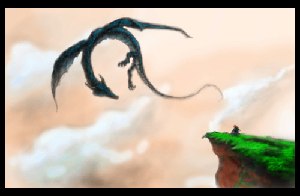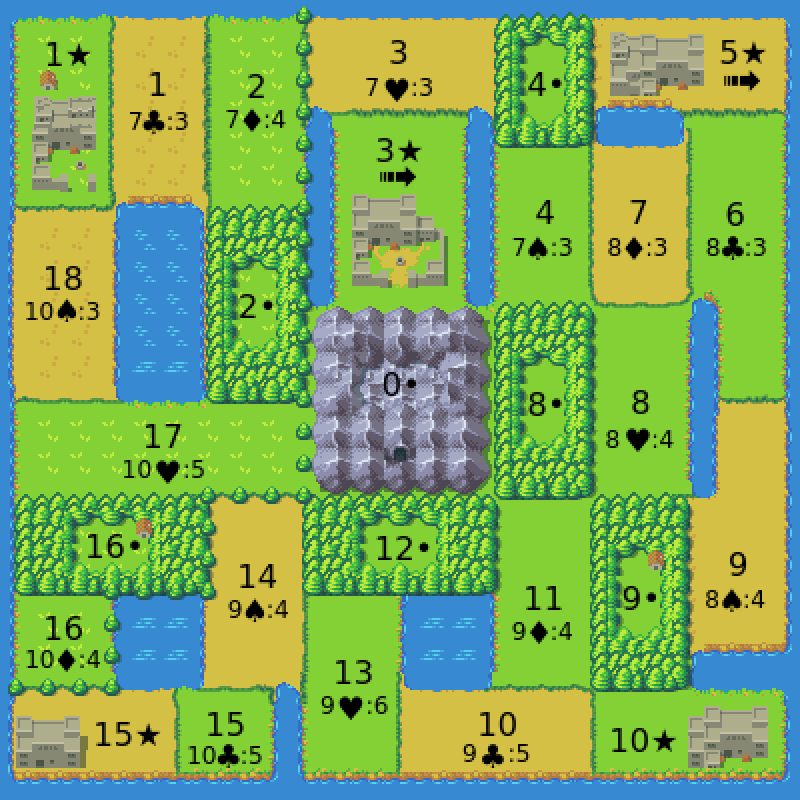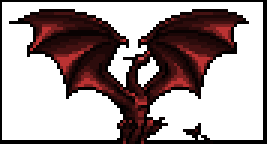
Dragon Dune
A game for 4 players inspired by Avalon-Hill's Dune board game.
This was formally called Dragons, Usurpers, and Empires (DU&E), but the Internet hates ampersands.
So, let’s justify this thing's existence. Dune is a great game, but it has its drawbacks. It's been out of print for 30+ years. The rules are kind of ambiguous. It can take a while to play. It can be tough to get 6 players together. Rex attempted to iron out some of these idiosyncrasies, but they removed things like binding agreements, which seem fundamentally important to a political wheeling-and-dealing game like Dune.
About This Game
This is an open-source, resource light game in the style of Avalon-Hill's Dune board game, that is friendlier to beginners, faster, easier logistically (4 players instead of 6), with greater rule clarity, and a strong sense of theme.
Four factions fight to control the of the land of the Red Dragon:
- The Dwarves, who sell their treasury of artifacts to the highest bidder to fund their armies.
- The Elves, cunning and mysterious, who possess arcane magic that reveals future events.
- The Goblins, who's bloodthirsty mercenaries fight for gold, even against their own king. Their thirst for treasure finds them with a trove of artifacts.
- The Orcs, who control the lands of the west. They worship the mighty Red Dragon.
Players take turns, buying artifacts to use in battle, recruiting forces and moving armies to collect gold and capture castles. All while a horde of wild dragons move through the land, decimating everything that comes before them.
Battle plans are made in secret and simultaneously revealed. Magic artifacts are used to support your armies. Even the winner of a battle can suffer terrible attrition.
Deals made publicly between players are magically bound, and must be honored, if possible. This, along with the tremendous cost of battle, adds a strong political component to the game.
Players may ally and share their advantages, but there can still be only one winner. The first player to end a turn controlling 3 or more castles has won the game. If there is no winner after 8 turns, then the Red Dragon still rules the land, and it's patron, the Orcs, win the game.
Details & Links
The game is the 8th Revision.
This game is licensed Creative Commons Share-Alike 4.0, by Vincent von Guard.
Contact: dragon.dune.game@gmail.com
Github: https://github.com/dragon-dune/dragon-dune
Web: http://dragondune.inkfox.org
PDF: http://pdf.dragondune.inkfox.org
Booklet: http://booklet.dragondune.inkfox.org
What You Need to Play:
- The Board
- Faction Unit Markers (4 factions, 10 per faction)
- Hidden Unit Markers (10 total)
- Gold Markers (approximately 60 total)
- Deck of Standard Playing Cards
- One Troll Marker
- One Dragon Marker
- One First Player Marker
Board:

Rules of Note:
- Territory 0• (in the middle of the board) is the Great Mountain and is neutral territory. Players will never battle in territory 0•.
- Forest territories are represented by • (such as 16•). Units in a forest territory are safe from dragon attack.
- Castle territories are represented by ★ (such as 10★). Players need to control 3 castles to win the game. Units in a castle are safe from dragon attack.
- A player controls a castle if they alone have at least one unit there. Hidden units have no effect on castle control.
- Players in control of 3★ or 5★ have access to griffins and receive a travel bonus. They may move through four territories in the movement round (instead of 2).
- Players may never have more than 10 units between on the board and the player's graveyard at any one time.
- No more than two players may have units in a castle at one time. Note that hidden units and the troll do not count as units for the purpose of this limit.
- Public agreements made in the game are binding and must be carried out, if possible. Public agreements can only be broken if all parties involved terminate the agreement.
- Players may form alliances, but there can still be only one winning player. Forming an alliance grants your ally an alliance power. Alliances can only be formed or broken during a Great Council after a Red Dragon. (This is a change from Dune, which allows to players to share a victory.)
- Players get one movement and one recruitment per round, unless another special effect allows it.
- All players placing units in the same territory as the Troll Marker (3★) lose 4 units in that territory at the end of the Movement Round. If there are still units in the territory after the units are removed, then the Troll Marker is also removed.
- Players may exchange gold at any time and for any reason, although players may never exchange artifacts.
- Units taking part in a battle are worth two battle points per unit.
- The game lasts for 8 turns.
Factions:

Dwarves (♦):
The Dwarves empire has fallen. The are forced to sell artifacts from their treasuries with the hope of one day reclaiming their birthright.
Start With: 5 Gold, 1 Artifact.
Starting Units: None.
Special:
- The Dwarves collect all gold spent by other players on on artifact cards. Gold spent by the Dwarves on artifact cards goes to the bank.
- The Dwarves may use their Jack as a Usurper (Queen) and their Queen as a Sabotaged Artifact (Jack). So, if they had the Queen of Spades and the Jack of Hearts, they could also play as though they had the Queen of Hearts and the Jack of Spades.
- In battle, the Dwarves add a bonus of 2 battle point to their total, unless they are fighting the Orcs.
- Special Card (Ace): In the Recruitment and Movement round, the Dwarves may discard a Special Card to remove 2 units from their graveyard.
- Alliance Power: Your ally receives one free artifact card per turn; your ally receives 1 gold from the bank every turn during the collection round.

Elves (♥):
The ancient Elves have vast arcane knowledge, but they will need to be clever to turn knowledge into gain.
Start With: 5 Gold, 1 Artifact.
Starting Units: 5 units in 5★.
Special:
- The Elves may see the artifact that is up for bid before bidding begins.
- In battle with the Elves (or their ally), the Elves may ask the color of their opponent's artifact card or to ask how many units their opponent sending in to battle before selecting their own card and units.
- At the beginning of the Recruitment and Movement Round, the Elves may see what the next event card will be.
- Elven units may go into hiding in a territory in order to escape conflict. Hidden units act in every way as though they did not exist. So, for example, they may not engage in combat, collect gold, be attacked by the Troll, or control a castle. Hidden units may only come out of hiding at the beginning of the Recruitment and Movement round or by moving into a territory where their units are not hiding.
- Special Card (Ace): Elves may ask both the color of their opponent's artifact card and ask how many units their opponent sending in to battle before selecting their own card and units.
- Alliance Power: Your ally may ask question before a battle just as the elves do.

Goblins (♠):
The Goblins are ruthless mercenaries who fight for coin, even against their own king. Their thirst for treasure finds them with a trove of artifacts.
Start With: 3 Gold, 2 artifacts.
Starting Units: 3 units in 10★.
Special:
- Goblins collect all gold spent on hiring Goblin mercenaries. Gold spent by the Goblins on mercenaries goes to the bank.
- The Goblins (and their ally) pay half price (rounded down) for Goblin mercenaries.
- When the Goblins win an artifact cards, they get a second artifact card that is hidden from the Elves.
- The Goblins may have up to 8 artifact cards (instead of 4).
- The Goblins (and their ally) may disband units at the beginning of the movement round (instead of at the end).
- The Goblins (and their ally) may disband units for free (instead of one gold per unit).
- Special Card (Ace): You may discard a special card to stop a player from hiring Goblin mercenaries that turn.
- Alliance Power: Your ally may may half price (rounded down) for Goblin mercenaries (even the Orcs may do this); you may disband units at the beginning of the movement round; you may disband units for free.

Orcs (♣):
The Orcs control the territories of the west. They worship the mighty Red Dragon.
Start With: 3 Gold, 1 artifact.
Starting Units: 5 units split between 1★, 9• & 16•.
Special:
- Orcs may not hire mercenaries. Instead, they my raise armies in Orcish territories (16, 16• , 17, 18, 1, 1★, 2, & 2•) at no cost.
- The Orcs (and their ally) may move units 3 territories in the movement round (instead of 2).
- The Orcs take only half losses (rounded down) against Dragons in the Dragon Round.
- The Orcs (and their ally) take no losses from the Red Dragon, which they worship.
- The Orcs may ride the Red Dragon when it appears, if they are in the same location.
- The Orcs (and their ally) may remove up to 3 units from the graveyard at no cost (instead of only receiving 1 free removal).
- In battle, the Orcs add a bonus of 1 battle point to their total.
- If no player has won at the end of the game, then Orcs are the default winner.
- Special Card (Ace): In the Dragon Round, you may move some or all of your units in any one territory to any other location.
- Alliance Power: Your ally may remove up to 3 units from the graveyard at no cost (instead of 1 free removal); your ally takes no losses from the Red Dragon; your ally may move units 3 territories in the movement round (instead of 2).

Cards:
Player Cards
- Dwarven Graveyard (King of Diamonds)
- Elven Graveyard (King of Hearts)
- Goblins Graveyard (King of Spades)
- Orc Graveyard (King of Clubs)
- Dwarven Usurper (Queen of Diamonds)
- Elven Usurper (Queen of Hearts)
- Goblin Usurper (Queen of Spades)
- Orc Usurper (Queen of Clubs)
- Sabotaged Clubs Artifact (Jack of Clubs)
- Sabotaged Diamond Artifact (Jack of Diamonds)
- Sabotaged Heart Artifact (Jack of Hearts)
- Sabotaged Spade Artifact (Jack of Spades)
Artifact Deck
- Special Card (Aces, All Suits)
- Artifacts (2 to 6, All Suits)
- Fire Artifacts (Hearts and Diamonds)
- Ice Artifacts (Spades and Clubs)
Event Deck
- Event Cards (7 to 10, All Suits)

Special Card Actions:
Aces are considered Special Cards.
Players may discard a Special Cards to:
- Not pay for an artifact card in the bidding round.
- Pay half of regular price (rounded down) for mercenaries in the Bidding and Recruitment round.
- Move through one additional territory with your moved units in in the Bidding and Recruitment round.
- Make your units in one territory hidden for one turn. This must be done as soon as the units share a territory with another player's units. The units come out of hiding at the the beginning of next turn's Recruitment and Movement round (at the same time that the elves choose to stay hidden or not).
Special Cards may also be discarded (by any player) to negate certain special abilities:
- May be played to stop the Elves (or ally) from asking a battle question.
- May be played to stop the Orcs from surviving a Red Dragon encounter.
- May be played to stop the Goblins (or ally) from disbanding units at the beginning of the Movement and Recruitment round (they may still disband at the end of the round).
- May be used to stop the Dwarves from using their Queen card as a Sabotaged Artifact and their Jack card as a Usurper.
Note: Special Cards cannot negate another special card action. So, for example, you could stop the elves from asking a battle question (per their normal power), but you could not stop them from using a Special Card to ask two battle questions.
How To Play:

Rounds:
Setup:
- The board is set up. Players place their starting units.
- If there are any Oracles, they make their victory predictions.
- One player is picked at random to be the Stating Player.
- The Dragon Marker is placed. Roll the die and multiply the number by three, then roll the die again and add that amount. This is the starting location of the Dragon Marker.
- Place the Troll Marker on 3★.
- If any other factions are not being played, place a Troll Marker in place of their starting units.
- Each player is given the King of their faction from the deck. They place this card face up in front of them. This is their graveyard. This is the only card that has to be shown. All other cards may be kept secret until used.
- Each player is dealt one of the Queens face down. Players may look at them.
- Each player is dealt one of the Jacks face down. Players may look at them.
- Each player is dealt one artifact card face down. Players may look at them.
- The Goblins are given a second artifact card face down, which they may look at.

I. Dragon Round:
The top card of the Artifact Deck is revealed. The Dragon Marker is moved that amount from its starting position through the board, in numerical order. The dragon goes through all territories with the same numerical value, so the dragon would go to both 1★ and 1 when the dragon was at 1. The revealed card is then placed in the Artifact discard pile.
- Note that the dragon marker never moves to territory 0•
Any units or gold the dragon marker encounters as it moves through the board that are not in a castle or forest are removed form the game.
- Note that Orcs only take half losses, rounded down.
- When the dragon marker reaches territory 18, it will next move to the 1★ and 1.
In the Recruitment and Movement round, players may never recruit units at or move units through or to a territory with the dragon marker.

II. Event Round:
A first card is revealed from the Event Deck and set aside. Then a second card is revealed from the Event Deck. If the second card revealed is the same suit as the card on the top of the discard pile, then the the Red Dragon appears at the at location of the card at the top of the discard pile.
If the Red Dragon appears, then:
- The Red Dragon has attacked the territory at the top of the event discard pile (the territory where the previous event took place). All units and gold in that territory are lost.
- If the Orcs are in the same territory as the Red Dragon, they may move some or all of their units at that location to any other location.
- In response to the appearance of the Red Dragon, a Great Council is called immediately. This is the only time players may form or break alliances. The Great Council continues until all players have passed or formed an alliance.
- The dragon marker does NOT go to the Red Dragons location. The dragon marker is only moved on the Dragon Round.
Two gold are placed on the location corresponding to the second revealed card, unless the dragon marker is at that location. The second card revealed is then placed on the Event Discard pile.
The amount of gold indicated on the board is placed on the location corresponding to the first card revealed, unless the dragon marker is at that location. The first card revealed is then placed on the Event Discard pile.

III. Bidding Round:
The Starting Player is the first Starting Bidder.
One card is placed up for bid for each player that does not have their maximum number of cards. For each card up for bid, one at a time.
- The Elves, and only the Elves, are shown the card.
- Players, starting with the Starting Bidder, bid on card. Note that players may continue to bid even if previously they had passed on the card.
The winner receives the card and pays the Dwarves.
- If the Dwarves win the artifact, their payment is payed to the bank.
- If the Goblins win the artifact, they receive a second artifact that is not revealed to the Elves.
- The winner may play a Special Card to avoid paying.
- The ally of the Dwarves my elect (on one card per turn) not to pay.
- The whole process repeats for the next player in player order. For each card, the next player after the current Starting Bidder (in player order) becomes the next Starting Bidder.
At the end of the Bidding Round, the Elves are shown the next event card.

IV. Recruitment and Movement Rounds:
The Elves must declare if any of their units are coming out of hiding. All non-elven hidden units come out of hiding.
Notes on Hidden Units:
- The Elves (or a player with a Special Card) must declare if their units go into hiding as soon as they share the territory with another player's units or with the Troll. They may not decide to go into hiding after the fact.
- If a player conscripts, moves, or recruits units into a territory where they already have units, then they must have the same status (hidden or unhidden) as the units that were already in the territory. If hidden units are moved into an empty territory then they may elect to come out of hiding.
Then, starting with the Starting Player, and the proceeding in player order, all players may (in the following order):
The current player may remove up to 3 units from the players graveyard. The first unit removed is free. The second and third units removed costs 1 gold each.
- The Orcs (and their ally) may remove all 3 units from their graveyard at no cost.
If the current player is the Goblins (or their ally) they may disband some or all of the units in one territory at no cost. Disbanded units are removed from the board, but do not go to the graveyard.
- Note that disbanding units at the beginning of the turn frees up units to be recruited at another location in that same turn.
- The current player may conscript up to 2 units from the bank onto any territory where they already have a unit. This action is free.
The current player may hire Goblin mercenaries at a cost of 1 gold per mercenary if it is in a city, or 2 gold per mercenary if it is into any other territory. The payment is made directly to the Goblins.
- Goblin mercenaries may not be hired in any territory where the dragon marker is present.
- Payments made by the Goblins (and their ally) are half price (rounded down).
- The Goblin's payment is made to the bank.
- The Orcs may not hire mercenaries. Instead, they my raise armies in Orcish territories (16, 16•, 17, 18, 1, 1★, 2, & 2•) at no cost.
- If the Orcs are allied with the Goblins then they may hire goblin mercenaries to any valid location at the usual rate, or may raise armies in the Orcish territories, but they may not do both.
- The player may play a Special Card to pay half the standard price (rounded down).
The current player may move some or all units from one location through two territories.
- Units may not move through or to any location where the dragon marker is present.
- The Orcs (and their ally) may move through up to three territories.
- If the player has access to griffins (if they control of 3★ or 5★) then they may move through four territories.
- The player may play a Special Card to extend their movement range by 1 territory.
- The current player may disband some, or all, of the units in one territory at the cost of one gold per unit. Disbanded units are removed from the board, but do not go to the graveyard.
The whole process repeats for the next player in player order.
After all players have taken their turns, then each player with units in the same territory as the Troll Marker has 4 units removed from that territory. If there are still units then the Troll Marker is also removed.

V. Battle Round:
Starting with the Starting Player, and the proceeding in player order, if a player has units in the same territory another player, they shall do the following (in the following order):
- The player whose turn it is is the attacking player.
- If the Elves (or their ally) are taking part in the battle, they may ask what color artifact their opponent will play, or ask the size of the army they will send into battle. The answers to these questions are binding.
- Each player secretly records how many units they will send as an army into battle, and they may select one artifact to use in the battle. For each unit sent into battle the army receives two points of battle value.
- Players reveal the size of their armies and their artifacts selected. Note that players may choose not to select an Artifact to use in battle.
For each color (red and black), whomever played the lower numbered artifact of that color, gets that amount added to their battle value.
If two artifacts of the same color are played, the higher valued artifact is discarded, regardless of who wins the battle.
If the two artifacts played are the same number and color, then both artifacts are destroyed.
- The player with the highest battle value wins the battle. In the case of a tie, the attacker wins.
- The winner removes all units used in an army in the battle.
- The loser removes all units from the territory, regardless of whether or not they took part in the battle. The loser also discards all artifact cards used.
- If a player who took part in the battle has a their opponent as their usurper, and has a sabotaged artifact of the same suit as the artifact their opponent played, then they may declare their treachery and automatically win the battle, taking no losses. The loser removes all units from the territory (even those not used in the battle), and discards any artifacts used in the battle. The winner also receives two gold.
- This process continues until all battles for a player are resolved.
Then the whole process repeats for the next player in player order.

VI. Collection Round:
- All players receive 1 gold.
- Players receive 1 gold for each castle they control.
- The Dwarves ally receives 1 gold.
- For any gold on the board, the player whom controls the territory the gold is in may collect two gold from the board for every unit in the territory, up to the amount of gold in the territory.
- If players wish, they may discard some or all of their artifacts.

VII. Victory Round:
- The next player (in player order) after the current Starting Player becomes the Starting Player for the next turn.
- If any player controls three castles then they have won the game.
If 8 turns have passed without a winner, then the Orcs win.
- If the Orcs are not playing, then whomever has the most castles wins. If there is a tie, then the tied players may fight with any units already present in 0• (normally a neutral territory), with the winner of the battle winning the game. If there is still winner, then the first of the tied players in player order is the winner.
If then game has not ended, then it goes back to the Dragon Round.
Optional Gameplay Mechanics:
Oracles
Before the game, players may decide to have have one or more Oracles. If a player is an Oracle then they secretly record the faction that predict to win the game, the turn they will win the game, and one castle that they will control when they win. Neither an Oracle victory or an Orc 6th round default victory may be predicted.
If the Oracle is correct in their prediction, then they are the winner. If two or more Oracles have predicted the win, then the player whose victory they predicted is the winner.
Weaknesses
Orcs and Goblins are weak against Ice Artifacts, Elves and Dwarves are weak against Fire Artifacts. In any battle in which your opponent successfully plays an Artifact that you are weak against, you lose 2 battle points from your total for that battle.
Optional Advanced Faction Powers:
What could be more Dune-like than having optional rules that no one can agree on. Here are additional faction powers that may add depth or help balance the game.
- Orcish Plunder: The Orcs may steal artifacts. When they win a battle, they may take one of their opponents artifacts (randomly chosen), which they may then keep or discard for a reward of 1 gold.
- Dwarven Elite Warriors: The Dwarves are fierce warriors. Two of their ten units are special units, which act as normal units in every way except that each special unit has a battle value of 3 (instead of 2 for regular units).
- Elven Blessing: After the Elves have lost 3 units in combat, they are given the power to invoke a blessing for one battle once per turn that gives them an bonus battle point and makes it so they can not be sabotaged for that battle.
- Goblin Initiative: The Goblins may take their turn in the Recruitment and Movement round at any time, regardless of player order.
Optional Advanced Special Card Actions:
Players may discard the following cards to take special actions:
- Six of Clubs: Discard during the Dragon Round to control the movement of the wild dragons, causing them to be moved an amount selected by the player (between 0 and 7) instead of the revealed Artifact card.
- Six of Diamonds: Discard during the Recruitment and Movement round to to remove 2 units from your graveyard.
- Six of Hearts: Discard during the Recruitment and Movement Round to to make a second movement (but not an extra shipping or extra conscription).
- Six of Spades: Discard to destroy the castle walls of one territory, as long as the player has a unit in that territory or an adjacent territory. Then, for the remainder of the game, that territory is no longer be safe from dragon attack on the Dragon Round.
Balancing Options:
The Goblins may be too powerful, and if this is found to be the case, then all players should receive an additional conscription.
The Orcs may be too powerful, and if this is the case, the Orcs should only be allowed to revive 2 units for free, instead of 3.
The Dwarves may be too powerful, and if this is the case the Emperor should receive 1 less gold for each artifact purchased (the 1 gold goes to the bank).
If the Elves are too powerful, then I don't know; maybe they start with 3 gold.
Special Thanks:
I would like to thank the creators of Dune and Rex.
I would like to thank artists that make their work available to the open source community.
- Jinn’s Icons (by Jinn) https://opengameart.org/content/jinns-icons
- Wyvern and Girl (by 5hiroi) https://opengameart.org/content/wyvern-and-girl
- Dragon head icon (by Lorc) http://game-icons.net/lorc/originals/dragon-head.html
- Crossed swords icon (by Lorc) http://game-icons.net/lorc/originals/crossed-swords.html
- Locked chest icon (by Lorc) http://game-icons.net/lorc/originals/locked-chest.html
- Card pickup icon (by Quoting) http://game-icons.net/quoting/originals/card-pickup.html
- Mounted knight icon (by Skoll) http://game-icons.net/skoll/originals/mounted-knight.html
- Coins icon (by Delapouite) http://game-icons.net/delapouite/originals/coins.html
- Poker Hand icon (by Lorc) http://game-icons.net/lorc/originals/poker-hand.html
- Ace icon (by Lorc) http://game-icons.net/lorc/originals/ace.html
- Overworld Tiles (by Buch) https://opengameart.org/content/overworld-tiles-0
- Throne king icon (by Delapouite under CC BY 3.0) http://game-icons.net/delapouite/originals/throne-king.html
- Battle axe icon (by Lorc under CC BY 3.0) http://game-icons.net/lorc/originals/battle-axe.html
- Wood club icon (by Delapouite under CC BY 3.0) http://game-icons.net/delapouite/originals/wood-club.html
- Bow arrow icon (by Delapouite under CC BY 3.0) http://game-icons.net/delapouite/originals/bow-arrow.html
- Sacrificial dagger icon (by Lorc under CC BY 3.0) http://game-icons.net/lorc/originals/sacrificial-dagger.html
- Diablo skull icon (by Lorc under CC BY 3.0) http://game-icons.net/lorc/originals/diablo-skull.html
- Crown coin icon (by Lorc under CC BY 3.0) http://game-icons.net/lorc/originals/crown-coin.html